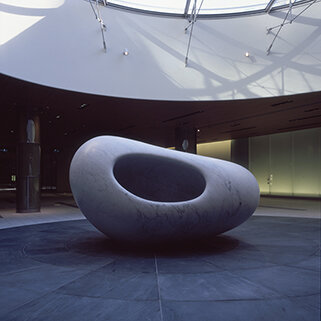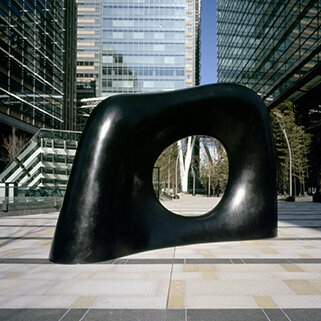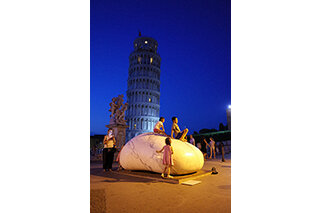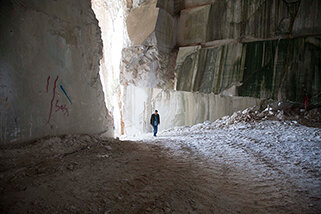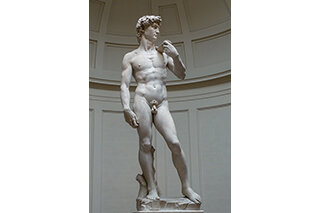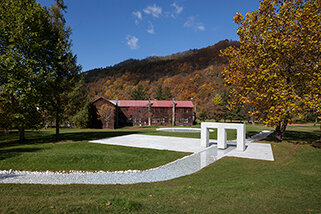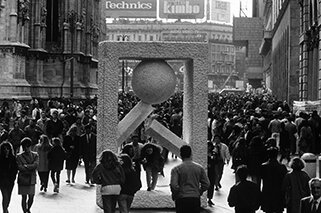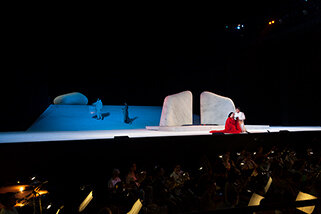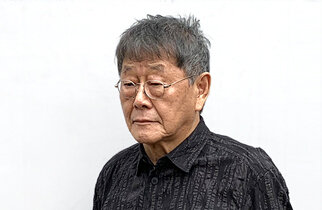
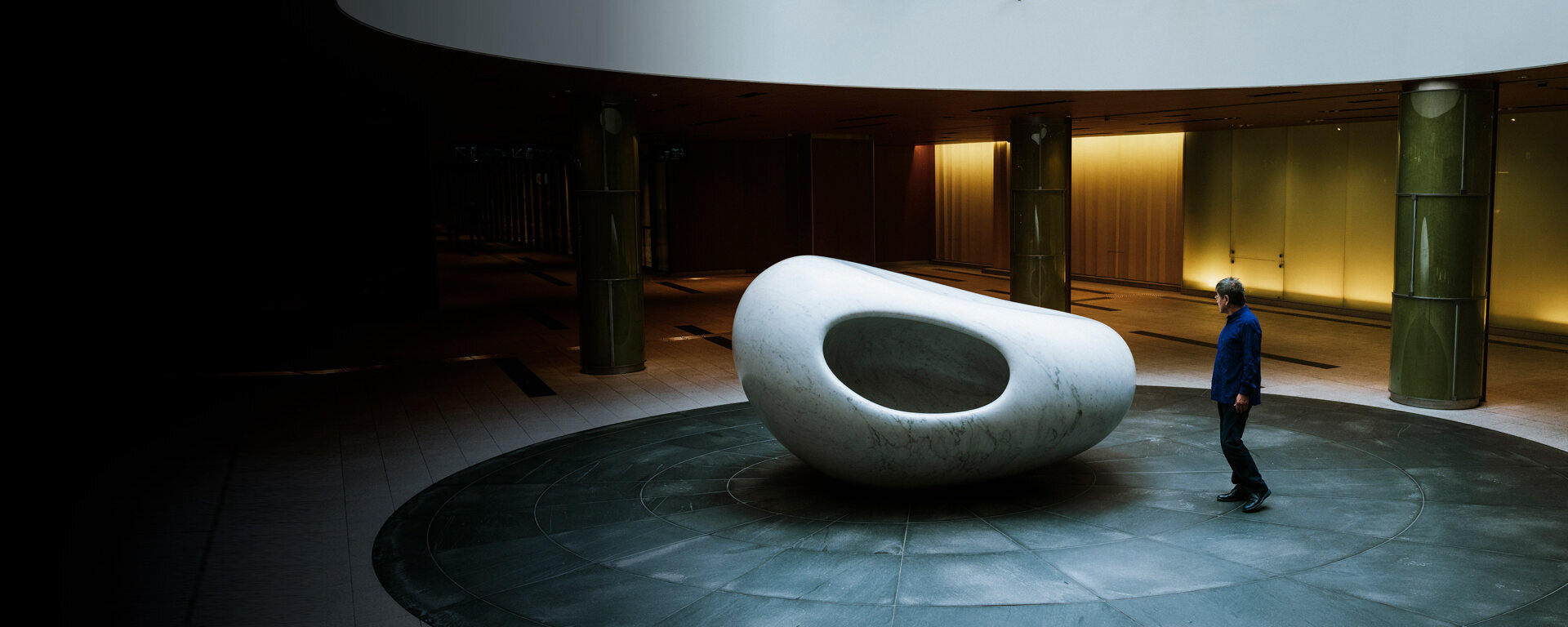
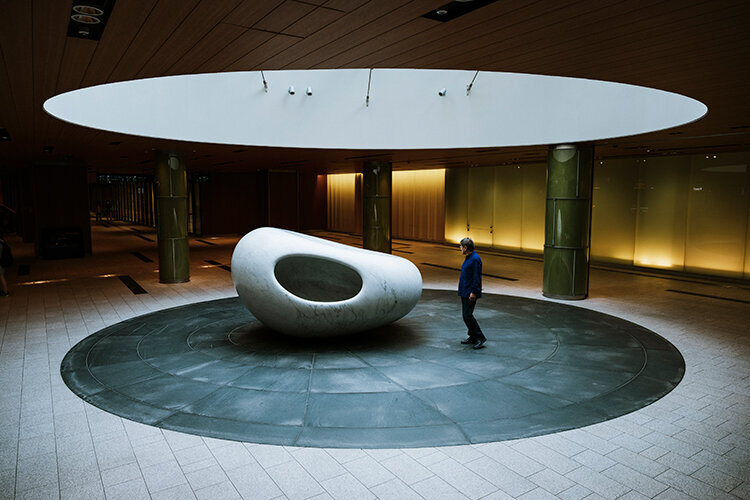
INTERVIEW
122
Kan YasudaSculptor
You can enjoy concerts around the sculptures
Savor your time with a sculptures and music
Kan Yasuda is an internationally renowned sculptor based in Pietrasanta, Italy. He infuses life into cold, inorganic stone, gradually breathing life and warmth into his creations. His beautiful sculptures boast smooth curves that convey a magnificence that encompasses cosmic aspects, but at the same time maintains a warmth and friendliness reminiscent of sitting next to a real person. How is he able to create such pieces? He shared his time to talk about his experiences in creating the pieces “ISHINKI” (Shape of Mind) and ”MYOMU” (Key to a Dream), that are permanently installed at Tokyo Midtown, and also about his thoughts on the mission of the art, the challenges of urban development, and what he wants to accomplish through sculptures.
What human-sized sculptures bring about
Since 1991, I have presented solo exhibitions (outdoor sculptures exhibitions) by employing the ambience of Italian cities, such as Milan and Florence. Italian cities have always been flush with a myriad of sculptures since ancient Roman times — Italy being the origin of public art. Placing sculptures within cities makes us think back about the history of cities and gives us something to help make the city's culture more prosperous — That has been my experience. One day, thanks to Prof. Toshio Shimizu, the current public artwork director at Tokyo Midtown and Mr. Jean-Hubert Martin, the former director of the Centre Pompidou, I heard of a public artwork competition held at Tokyo Midtown in Roppongi. That is how I started to work with Tokyo Midtown.
I went in person to see the site where art pieces would be displayed, then went back to Italy and prepared a miniature piece from marble. When I presented the miniature at the competition in Tokyo, I saw smiling faces on all the committee members. They were cradling my miniature with both hands. Apparently, they liked my artwork "ISHINKI" (Shape of Mind) and the team I belonged to won the competition. I remember how happy I was to know my pieces were chosen over all the other presentations.
ISHINKI (Shape of Mind)
Created by Kan Yasuda in 2006. The sculpture is placed on the basement first floor of the Plaza, Tokyo Midtown. Yasuda carved it out of marble into smooth curves. Marble has been formed in the earth from time immemorial. His artwork from marble conveys breaths of the earth and the vital warmth of humanity.
Two of my artworks are permanently installed at Tokyo Midtown. One is "ISHINKI" on the basement floor in the Plaza. I once learned of a legendary tradition that a white stone placed in a house will bring luck. I have always worked with marble so that story sounded fascinating to me. Therefore, I thought to place a white marble stone on the basement floor so that people can sense part of the earth through the marble — I started with this artwork in that way.
Another is "MYOMU" (Key to a Dream), which you can find on the first floor of the Plaza. It is installed at a site resembling a main entrance of the complex, a spacious ambience with a building of great dimensions behind. Humans usually feel fear when standing in front of such a gargantuan building. But if we add only a single human-sized sculpture, one that is only a little bigger than a human, the uncomfortable tension will dissipate. My artworks are not displayed on a plinth so people can touch them if they desire. Bronze and marble are parts of the earth so these pieces with friendly smooth curves can convey an inviting warmth.
MYOMU (Key to a Dream)
A bronze sculpture created by Kan Yasuda in 2006. The round cavity at the center is for people to draw a dream and make a wish. You can see transitions of its form and aspects with daylight and shadows cast by the sun.
Public art and humans can share spirituality
Most contemporary buildings are covered with glass and have frames made of stainless steel, aluminum and such cold hard materials, giving this style of architecture an unfriendly aura. When a human-sized sculpture is thrown into such an inorganic world, the world instantly changes into a space full of spirituality. "Spirituality" might sound a bit nebulous, in other words, it is the human emotions such as happiness, joy, sadness, and pain. Sculptures and humans can share this kind of spirituality. Sculptures that can share the essentials of human emotions with all of humanity is what public art epitomizes, I think.
I hear some people greet my sculptures like friends. If you see the same sculpture on the way to the office every day for years or decades, the sculpture seems to become a living being. Resonance is born between them, and both start to say, even silently, "Good morning" and "Goodbye" on the way to and from the office. Sculptures just stand there and do not complain on rainy or windy days. Sculptures do not merely "exist." They are there to stay. Only those who sense such feelings can share happiness and sadness and converse with the sculpture. The sculptures should stare at you every day. (laughter)
"ISHINKI" and "MYOMU" both incorporate similar holes. Outside, "MYOMU" inhales light through its central hole and creates a space for people to draw a dream. A kind of vital air then flows through a skylight next to "MYOMU" down to the basement floor where "ISHINKI" awaits above the earth. Celestial light and terrestrial stone are connected through the space of these holes. Few people notice that (laughter), but rarely does a person instinctively feel that connection. I feel so happy to see such people glean into my intention.

Children teach us how to "transcend"
Speaking about the sculpture holes, the hole I created in "ISHINKI" is a kind of cave where people can lean in close to the inside of the earth. Passersby might see children slip into the hole for a while, while mothers nag them to get out, saying "We're going home. Come here!" Being inside the hole makes you feel cozy because the shape is the same as a mother's womb. If you hide yourself at the corner of the hole and peek out from the inside, you feel like you are seeing the exterior surface of the globe. While seeing such a grand view, the stone surrounds and protects you, insulating you into a sense of comfort and safety.
Children, regardless of nationality, show similar reactions when they touch "ISHINKI" and my other artworks. I am sometimes asked why children want to touch my artworks. I never asked them to touch. Children are taught not to touch this and that outside their houses since they are small. But they know they are allowed to touch my artworks. Once they find my sculptures, they approach from far away as if to say they "will touch" and "will go inside," walking briskly, then running and letting go of their mothers' hand. Children touch, climb, and go into the sculptures by instinct.
"ISHINKI" and the Leaning Tower of Pisa
An exhibition was held in Pisa, Italy in 2016. Children gathered and played spontaneously.
It is said that art has no national boundaries, races, nor religion. It is a beautiful sentiment, but the reality is much harsher. Watching children spontaneously touch artworks, I feel they represent how to transcend national boundaries, races and religion. Children of any nationality touch artworks, sharing the same feeling with no help from logic, even without knowing letters, languages or culture. I believe the mission of art is to transcend everything just as children teach us.
Stone offers two kinds of time axes
The marble that "ISHINKI" was carved from was brought from Pietrasanta, Italy, where I lived for 49 years. Pietrasanta is called the mecca of sculptor. As many as 200 sculptures come to the city from around the world. My studio is at the foot of the mountain and I can see quarries from my studio. Actually, Michelangelo used to come to the quarries to look for stones. While working at the studio, I sometimes look up and see white stones spread out before me. Michelangelo strove to create his artworks just over there. I am moved and encouraged by such thoughts. It is a utopia of sculptors. If I am ever asked to declare my most favorite place in the world, my answer is definitely Pietrasanta.
Quarry
One of the world's largest stone quarries. Mr. Yasuda can see the quarry from his studio. Exceptionally beautiful marble can be quarried in the site situated at the top of the marble mountain. Michelangelo used to look for marble here for his sculptures. Pietrasanta is a beautiful and quiet local city in Lucca Province, Tuscany, in northern Italy. Mr. Yasuda has lived here since 1974 and has his own studio. Shown here is the quarry where Michelangelo used to look for stone materials.
You can see stones everywhere in Rome (laughter). Sculptures made some 2,000 years ago are an integral part of the city. Sculptors are more like parents to such artworks in the city. Every time I release my artworks, I send them off saying "Breathe the air of this place and live long." Once stones are placed, they should live at the same place for decades, hundreds, or maybe thousands of years. The Statue of David by Michelangelo has lived for 500 years. I was just there to meet him and felt he will live on for many more. Because a spirit dwells inside that statue.
The Statue of David
Sculpture by Michelangelo, dating 1501 - 1504 is considered a masterpiece representing the Renaissance. The marble was transported from a quarry in Carrara to Firenze at the expense of manual labor and high transportation costs. Housed in the Galleria dell'Accademia (Gallery of the Academy of Florence)
In my opinion, sculptures make us feel two kinds of time axes. Sculptures encompass the two, surpassing liminality by bridging "the continuous time" and "the moment." "The continuous time" is in which the sculpture itself endures. It is like a length of time that only that sculpture has experienced while having kept observing the city and people for thousands of years. In that continuous time, there is "the moment" when the sculpture and a person have contact. Take for example — A person who touched "MYOMU" or "ISHINKI" in their childhood, and then reencounters the same artwork 30 or 50 years later. That person should look back with nostalgia; "I think I touched this stone" and "Maybe I slipped into this hole." Two time axes then come to appear, "the continuous time" that has been running for decades and "the moment" when touching the sculpture. Only the person blessed with a chance to reencounter can enjoy these two time axes. These two time axes can only be shared between the sculpture and that blessed person.

Italy respects strict rules in urban development
The city where I live has strict rules regarding urban development. When I was planning to build my art studio, initially I was unable to obtain permission from the municipal office. I observed every rule, such as roofing materials, color of roof tiles and walls, and sash doors, but I wasn't able to build my studio. I inquired as to the reason why and was told my chosen material for rainwater gutters was unacceptable. My studio was under restoration at the time and I was told that plastic rainwater gutters would disturb the rural landscapes of Italy and therefore, I had to use the traditional copper ones. Cities in Italy, from North to South, respect strict rules and have a uniform mindset in planning their cities. Behind those landscapes and scenery are collective patience, learning, and costs born by Italian people.
Kan Yasuda Sculpture Museum Arte Piazza Bibai
Mr. Yasuda has his studio in Pietrasanta, Italy. And in Bibai, Hokkaido, Japan, where he was born, there is the museum with his sculptures. Surrounded by mountains, there used to be an elementary school in this erstwhile coal mining city. With his dream to create a park for adults and children to stretch and release their souls and minds, the site was reborn as "Kan Yasuda Sculpture Museum Arte Piazza Bibai." The museum is still being created in the pursuit of an ideal state among nature, human and the arts.
Photo: by Shigeo Ogawa
The symbol of the art city was controversial
When we see European cities, we notice that the city authorities, for example Paris, designate zones and impose strict laws with regard to construction. On the other hand, Paris shows a unique facet to urban planning with audacious architectural designs such as the Centre Pompidou. The Centre Pompidou was designed by Renzo Piano whom I have worked with on another project. The Centre was named after Georges Jean Raymond Pompidou who served as a President of France. It is said that he and his wife had supported Renzo's idea to the very end, but the majority of people were against his idea. The museum inside was realized as the result of controversy and the museum alone resides as a great presence that sustains Paris, the city of art. Afterwards, Renzo's audacious endeavor has been influencing the arts in other European countries.
The Centre Pompidou
The art center dedicated to modern and contemporary art was inaugurated in Paris in 1977. Georges Jean Raymond Pompidou, who served as President (1969-1974) announced the concept, and Renzo Piano and Richard Rogers designed the architecture.
European countries preserve their old-town atmosphere by imposing rules such as limited color palettes and height restrictions for buildings in designated areas. But they also challenged something new. Their comprehensive city planning is contributing to the beauty of traditional scenery in Europe. To the contrary, Japan has neither the laws nor the extensive frameworks. Living in Italy, I always feel that enormous divide.
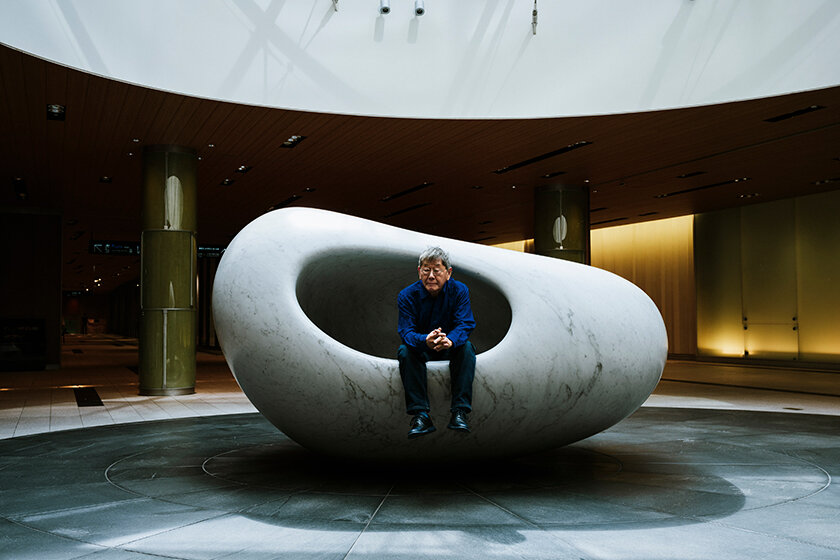
Developing new cities where their identities remain alive
Japan used to have a very beautiful old-town atmosphere. In the Edo period, the city had a spacious uniformity well comparable to the beauty of European cities. Unfortunate incidents such as wars, earthquakes and fires forced us to plan new cities from scratch. There are surviving cities like Asakusa, Ueno and Yanaka where bygone panorama and landscapes are still alive. One of Japan's major issues is to come up with a framework for architecture leading to the development of new cities while maintaining the cities' historic identities.
Inspired by Italy's exhibitions, I would like to employ one idea
I have been involved in a variety of public art projects. Among the most impressive are sculpture exhibitions that were held in eight cities in Italy. Each city acted as the organizer and each of them held their exhibition by utilizing the entire city. To do so, central streets were closed to vehicles. One of my dreams is to employ such a project in Tokyo, hopefully in Ginza. The streets of Ginza turn into a pedestrian precinct on Saturdays and Sundays so we can do it only by extending that period for three months (laughter). They say it is extremely difficult to try something special in Tokyo. Usually no one believes such an idea will work in Tokyo. Anyone will say it is just impossible. But if we dare to change using something out-of-the-box I believe we will see a renascence of vibrant Tokyo.
Sculpture exhibitions at eight cities
Exhibitions were held in Milan, Pietrasanta, Florence, Assisi, Rome, Taormina, Torino and Pisa. A number of sculptures were scattered around the city. Visitors were surprised and profoundly moved.
The project started in Milan in 1991 and was finalized in Pisa in 2016. Each city has its own character, history and culture. I learned a lot from the tour of eight cities over 25 years. In Florence, eight squares or piazzas of the Renaissance period were used for the exhibition. In the Roman Forum in Rome, it was held in the Mercati di Traiano, Museo dei Fori Imperiali, which is the world's sole museum inside ancient ruins. The exhibition was titled "Touching the time" where nothing was visible nor tangible. In Rome, they praised our project stating that abstract contemporary sculptures standing in ancient ruins dating back to 2000 years ago gives viewers something to connect the past, the present and the future. They decided to permanently place an "ISHINKI" in white bronze there. I was moved by the profoundness and gravity of Italians and their culture.
"ISHINKI" in white bronze
This piece is permanently placed in the ancient Trajan Markets. In the background you see the Victor Emmanuel II National Monument (Monumento Nazionale a Vittorio Emanuele II).
I have another idea that I believe we can do right now — Concerts around "ISHINKI" at Tokyo Midtown. With COVID-19, young students in the arts are missing opportunities to perform. We might propose to universities of music that they can give performances at this venue. It would also make for a wonderful occasion for these students to test their courage. Sculptures and music have good chemistry. Some of the audience might come earlier then, to slip into "ISHINKI" through the hole (laughter). Listening to music while lying in its hole is truly an unsurpassable experience.
It's all a matter of moving people to tears through art; art is a mirror to reflect your heart
Speaking of music, I have been working on operatic theatre projects with the Puccini Foundation in Torre del Lago for about a decade. Staff members from the Foundation gave me very sweet comments such as; my sculptures encapsulate the juxtapositions of death-love and life-sorrow through which I captured the soul of Cho-Cho-san in these four elements. I was somewhat emboldened by their words and decided to create a space for Madame Butterfly. The actors sing on a stage with only these four sculptures placed. I have expressed a complete abstract form of the sad love story of Madame Butterfly. I totally removed any visual elements that would indicate "this is a Japanese person." By doing so, her love became universal and her soul gives a visceral immediacy to the audience. That was an unprecedented approach to the interpretation of the work for the first time in one hundred years, and I am honored to have received the Puccini Award. Maybe It seems like I am bragging, but it is the same prestigious award that Maria Callas received.
Madame Butterfly
Renowned opera by Giacomo Puccini about the sad love story of Mr. Pinkerton, an American naval officer, and Cho-Cho-san who used to be the daughter of a samurai family. Mr. Yasuda produced its theatrical art in 2000. The performance was presented in Germany, the United States, Japan and Korea, and is still being presented in Italy.
Audiences flock to the theater by the lake in Torre del Lago for Madame Butterfly every year. They see the same program every year but they cry their eyes out. After each performance, I hear their lively conversations like, "Did you cry?" "It made me cry!" "Well, that's good, but I didn't." I believe they reflected on Cho-Cho-san's love story in their own life and what they are saying could be translated like; "You cried because you are living a good life." "I didn't cry as I'm not living a good life at the moment." I believe this is what art is all about.
It's all a matter of moving people to tears through art. What matters is how we let the spirituality dwell in the object. How we can accept and have compassion for people's feelings using sculptures as a form of medium. I have been contemplating this subject and am now thinking that this empathy could be possible if art becomes a mirror reflecting a person's heart. When art becomes a mirror that reflects your heart, you can see sorrow, difficulty, and joy inside yourself. No one can console you except for yourself, but it should be really meaningful to just understand for yourself feeling sad or happy. The mission of art is to reflect the people's hearts and let viewers know the spirituality inside themselves, and I believe that is the essence of the art.
Editor's thoughts
Mr. Kan Yasuda is a singularly charming person — If I may be bold enough to say this to the internationally renowned sculptor. During the photo shoot, Mr. Yasuda bunked down into the hole of "ISHINKI," laughing and saying, "I know how comfy this is because I carved it myself." Noticing that our staff had materials printed on Kraft paper, he smiled and said, "I should have used that paper!" He still has a pure juvenile mentality and profoundly observes art with his unsullied spirituality — That is why he can deeply connect with the stone.(text_akiko miyaura)
RANKING
ALL
CATEGORY




